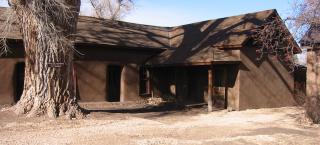
Grant News
"Paradise Enough for Me": Fort Francisco's Preservation
Legend tells us that Col. John M. Francisco, upon reaching the verdant Upper Cuchara Valley in present-day Huerfano County in 1862, declared, "This is paradise enough for me," and settled down. To ward off potential attacks by Native Americans and to encourage commerce, he and his French Canadian partner, Henry Daigre, built a four-sided adobe fort with a central plaza. The fort became the social and commercial hub for Francisco, Daigre, and a small community of farmers and ranchers that located in the valley. In 1876 William Jackson Palmer's Denver & Rio Grande Railroad Company laid tracks westward through present-day Huerfano County and over La Veta Pass to the San Luis Valley. The company platted the town of La Veta next to the fort. Over 140 years later, the fort continues to contribute to the region's cultural identity through a museum housed within its mud-brick walls. However, by the mid-1990s, the fort began to display signs of its age.
A long list of structural problems, including crumbling adobe walls and a wooden beam and earthen roof that was literally falling on the museum's exhibits, threatened the fort's integrity. Without immediate corrective action, this National Register property might have deteriorated beyond repair. Its loss would not only have robbed La Veta of a significant architectural treasure, but would have also hampered the Huerfano County Historical Society's ability to teach history.
Fort Francisco Museum's staff and volunteers educate schoolchildren, tourists, and locals about the region's past through exhibits and through the structures themselves. In addition to interpreting the plaza area-which includes the original 1862 buildings-the Huerfano County Historical Society (HCHS) oversees an 1880s saloon, the Ritter School, a blacksmith shop, hornos (adobe ovens), and a mining museum.
By examining a textbook collection of projectile points in the fort, students learn how Native Americans inhabited the region for hundreds, and perhaps thousands, of years prior to Col. Francisco's arrival. They learn that authorities established the area's first post office at the fort in 1871, naming it Spanish Peaks for the two high mountains that dominate the landscape. Sometimes that name recalls stories about seventeenth and eighteenth-century Spanish military expeditions sent from Santa Fe to expand what was once part of a global colonial empire. Students learn that Spain, and later Mexico, encouraged settlement on this New World frontier by giving large expanses of territory to individuals representing groups of families. Col. Francisco and Henry Daigre received permission to settle on portions of the former Vigil and St. Vrain Land Grant from the original grantees. Visitors leave the fort with an appreciation for the region's continuous and overlapping occupation by indigenous peoples, Spanish explorers and soldiers, Hispanic settlers, and farmers, ranchers, miners, and businesspeople.
In order to preserve the buildings and the stories they tell about the region's past, the fort's stewards-including the HCHS, the Town of La Veta, and a private couple that owns part of the fort's west wing-rehabilitated the site's structures in several projects that were financed, in part, by the State Historical Fund. First, they addressed some of the worst structural problems by stabilizing the fort's east wing. Second, they conducted a structural analysis of the museum buildings. The resulting report recommended further stabilization and rehabilitation projects. Next, the preservation team formulated a master site plan. Armed with a deep understanding of the fort's preservation needs outlined in the master plan and structural report, the group then rehabilitated the fort's west wing. Contractors stabilized the foundation, removed non-contributing elements (such as cement stucco and the asphalt driveway), repaired and refinished exterior adobe stucco, rebuilt an exterior adobe wall, and fixed the roof. Jerry and Peggy Davis, who own several rooms in the west wing, invested much of their own money in the final project. Their commitment, matched by monetary and in-kind donations from the Town of La Veta and the HCHS, demonstrated how a public-private partnership can benefit a community through heritage tourism.
Today, Fort Francisco remains Huerfano County's prime history education facility and an authentic tourist attraction. Moreover, the entire series of preservation projects injected more than $203,500 in State Historical Fund grants into the local economy. Matching funds and related expenditures raise that figure to a far greater level. The HCHS and the State Historical Fund hope that this project, one of the largest of its kind in Huerfano County, will serve as a model for other small communities that are interested in the benefits of historic preservation.
